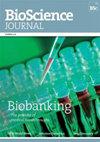亚马逊河流域可可的遗传变异性:对遗传保护的启示
IF 0.6
4区 农林科学
Q3 AGRICULTURE, MULTIDISCIPLINARY
引用次数: 0
摘要
可可和巧克力生产链每年涉及600亿美元和全球300万农民,面积超过900万公顷。利用野生种质资源将有助于培育新的抗病虫害品种和适应不断变化环境的能力。在这里,我们基于8个果实性状对来自9个亚马逊盆地的145个可可品种进行了评估。单因素方差分析显示,各性状差异均显著(p<0.05)。7个性状在流域内的方差均较高,平均为81.5%。因此,建议在收集野生植物资料时,优先选择分布最广的盆地中少数种群的大量植物。多变量分析结果表明,Ji-Paraná-RO和Solimões/Amazonas-PA盆地之间存在较大的差异(27.69),而Alien克隆- per和Solimões/Amazonas-AM之间存在较大的相似性(0.66)。研究还揭示了不同流域体系的植物资源存在分异。这些结果有助于阐明可可种群的遗传结构和分布。加强种质资源的收集和保存,保护遗传资源。本文章由计算机程序翻译,如有差异,请以英文原文为准。
Genetic variability of cocoa from the amazon basin: implications for genetic conservation
The cocoa and chocolate production chain involves US$60 billion annually and three million farmers around the world, in an area exceeding nine million hectares. The use of wild germplasm will enable to generate new disease- and pest-resistant cultivars and ability to adapt to changing environments. Here we evaluated 145 cocoa accessions, originated from nine Amazonian basins, based on eight fruit traits. Univariate anova showed significant differences (p<0.05) for all traits. For seven traits, the variance component within basins was higher (81.5%, on average). Therefore, it is recommended that the collection of wild accessions prioritize a larger number of plants from a few populations of the most divergent basins. The multivariate analyses revealed a greater divergence between the Ji-Paraná-RO and Solimões/Amazonas-PA basins (27.69) and a greater similarity between Alien clones-PER and Solimões/Amazonas-AM (0.66) in relation to their populations. They also revealed that the accessions differentiation occurred according to the river basin system. These results allowed elucidate the genetic structure and distribution of cacao populations. In addition, strengthen the importance of collecting and conserving germplasm to preserve genetic resources.
求助全文
通过发布文献求助,成功后即可免费获取论文全文。
去求助
来源期刊

Bioscience Journal
Agricultural and Biological Sciences-General Agricultural and Biological Sciences
CiteScore
1.00
自引率
0.00%
发文量
90
审稿时长
48 weeks
期刊介绍:
The Bioscience Journal is an interdisciplinary electronic journal that publishes scientific articles in the areas of Agricultural Sciences, Biological Sciences and Health Sciences. Its mission is to disseminate new knowledge while contributing to the development of science in the country and in the world. The journal is published in a continuous flow, in English. The opinions and concepts expressed in the published articles are the sole responsibility of their authors.
 求助内容:
求助内容: 应助结果提醒方式:
应助结果提醒方式:


